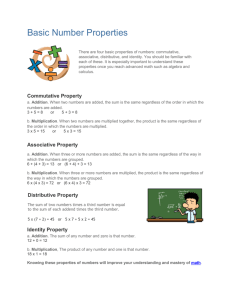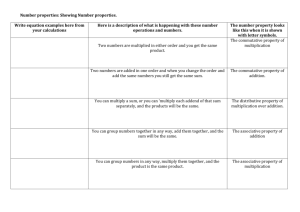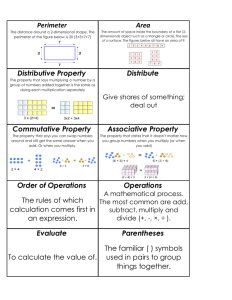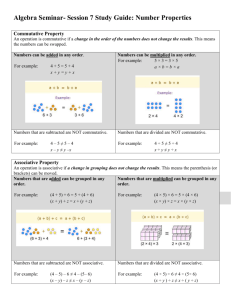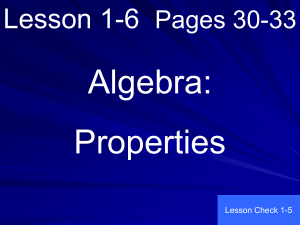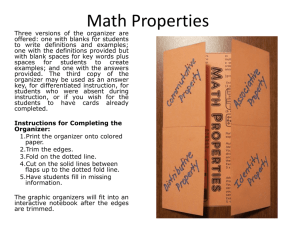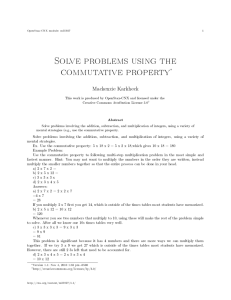Number properties Equations Here is a description of what is
advertisement
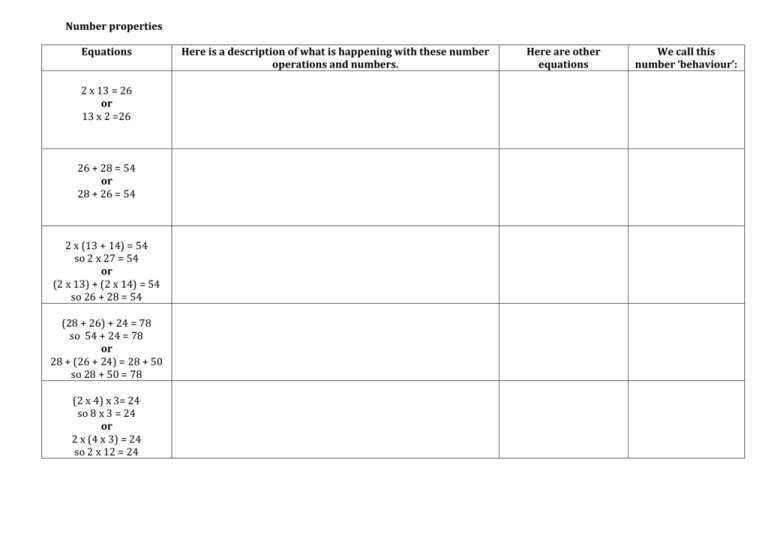
Number properties Equations 2 x 13 = 26 or 13 x 2 =26 26 + 28 = 54 or 28 + 26 = 54 2 x (13 + 14) = 54 so 2 x 27 = 54 or (2 x 13) + (2 x 14) = 54 so 26 + 28 = 54 (28 + 26) + 24 = 78 so 54 + 24 = 78 or 28 + (26 + 24) = 28 + 50 so 28 + 50 = 78 (2 x 4) x 3= 24 so 8 x 3 = 24 or 2 x (4 x 3) = 24 so 2 x 12 = 24 Here is a description of what is happening with these number operations and numbers. Here are other equations We call this number ‘behaviour’: Number properties: Teacher notes Equations 2 x 13 = 26 or 13 x 2 =26 26 + 28 = 54 or 28 + 26 = 54 2 x (13 + 14) = 54 so 2 x 27 = 54 or (2 x 13) + (2 x 14 ) = 54 so 26 + 28 = 54 (28 + 26) + 24 = 78 so 54 + 24 = 78 or 28 + (26 + 24) = 28 + 50 so 28 + 50 = 78 (2 x 4) x 3= 24 so 8 x 3 = 24 or 2 x (4 x 3) = 24 so 2 x 12 = 24 Here is a description of what is happening with these number operations and numbers. “It doesn’t matter if the numbers are swapped around when you multiply them. It’s still equal to the same thing.” Two numbers are multiplied in either order and you get the same product. (This is called the commutative property of multiplication because when a x b = b x a we say a and b ‘commute’ with each other.) “It doesn’t matter if the numbers are swapped around when you add them. It’s still equal to the same thing. The sentence still balances” Two numbers are added in one order and when you change the order and add the same numbers you still get the same sum. (This is called the commutative property of addition because when a + b = b + a we say a and b ‘commute’ with each other.) You can multiply a sum, or you can ‘multiply each addend of that sum separately, and the products will be the same. Here are other equations 4 x 3 = 12 or 3 x 4 = 12 We call this number ‘behaviour’: The commutative property of multiplication The commutative property of addition. The distributive property of multiplication over addition. (This is called the distributive property because you are distributing something as you separate it or break it into parts.) “When you add three numbers it doesn’t matter if you start with the first pair or the last pair.” You can group numbers together in any way, add them together, and the sum will be the same. (This is called the associative property because the numbers can be grouped (or ‘associated’) in different ways, but the same sum results.) “When you multiply three numbers it doesn’t matter if you start with the first pair or the last pair.” You can group numbers in any way, multiply them together, and the product is the same. (This is called the associative property because the numbers can be grouped (or ‘associated’) in different ways, but the same product results.) (14 + 14)+ (13 + 13)= 54 or (14 + 13) + (14 + 13)= 54 The associative property of addition The associative property of multiplication
